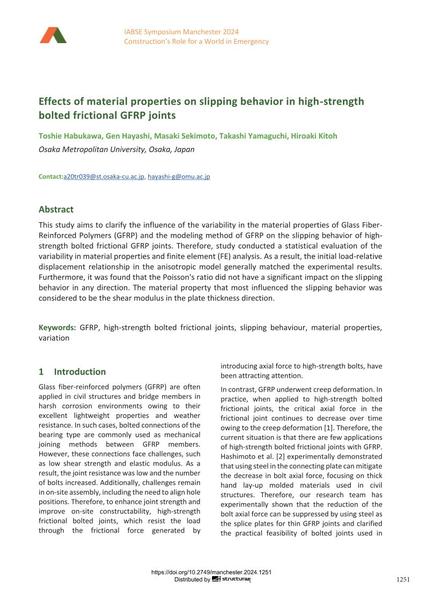Effects of material properties on slipping behavior in high-strength bolted frictional GFRP joints

|
|
|||||||||||
Détails bibliographiques
| Auteur(s): |
Toshie Habukawa
(Osaka Metropolitan University, Osaka, Japan)
Gen Hayashi (Osaka Metropolitan University, Osaka, Japan) Masaki Sekimoto (Osaka Metropolitan University, Osaka, Japan) Takashi Yamaguchi (Osaka Metropolitan University, Osaka, Japan) Hiroaki Kitoh (Osaka Metropolitan University, Osaka, Japan) |
||||
|---|---|---|---|---|---|
| Médium: | papier de conférence | ||||
| Langue(s): | anglais | ||||
| Conférence: | IABSE Symposium: Construction’s Role for a World in Emergency, Manchester, United Kingdom, 10-14 April 2024 | ||||
| Publié dans: | IABSE Symposium Manchester 2024 | ||||
|
|||||
| Page(s): | 1251-1259 | ||||
| Nombre total de pages (du PDF): | 9 | ||||
| DOI: | 10.2749/manchester.2024.1251 | ||||
| Abstrait: |
This study aims to clarify the influence of the variability in the material properties of Glass Fiber- Reinforced Polymers (GFRP) and the modeling method of GFRP on the slipping behavior of high- strength bolted frictional GFRP joints. Therefore, study conducted a statistical evaluation of the variability in material properties and finite element (FE) analysis. As a result, the initial load-relative displacement relationship in the anisotropic model generally matched the experimental results. Furthermore, it was found that the Poisson's ratio did not have a significant impact on the slipping behavior in any direction. The material property that most influenced the slipping behavior was considered to be the shear modulus in the plate thickness direction. |
||||
